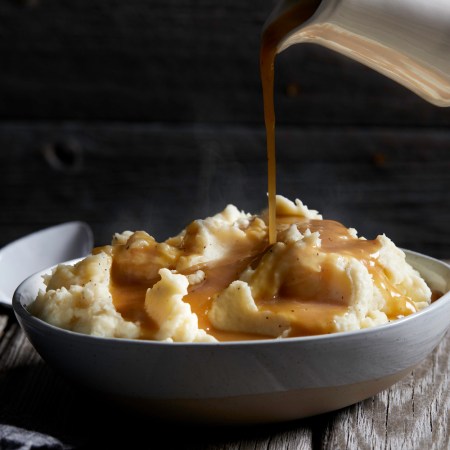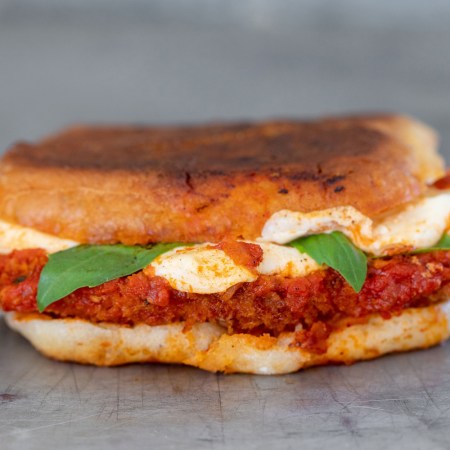Last winter — or perhaps it was two winters ago? — in the midst of all the unpleasantness, many people turned to the warming, comforting and most importantly time-killing hobby of making their own sourdough bread at home.
Having already established herself as a sourdough specialist, Gage & Tollner’s pastry chef Caroline Schiff decided to write an entire cookbook about baking with sourdough. At the time, the classic Brooklyn steakhouse where she works had shut down due to COVID-19 just one day before it was supposed to reopen after a lengthy closure.
Born out of the pandemic, The Sweet Side of Sourdough is meant to be an approachable guide for aspiring home bakers, with 50 recipes that range from cakes and cookies to pie crusts and layer cakes. Also: honey-glazed pull-apart bread.
Though not the same as the pull-apart-esque Parker House rolls offered at Gage & Tollner, the pull-apart bread in Schiff‘s book is similar in that it bakes together in perfect little portions that can be torn off like petals from a flower. Made with butter, eggs and milk, Schiff‘s glazed pull-apart bread is a sweet, rich, delightful treat.
“I think there’s just something so very wonderful and comforting about pulling apart a piece of bread. They are just this nostalgic bread and really fun to eat,” Schiff tells InsideHook. “You get your hands involved and everything. There’s something special about them. The one I created for the book is intricate in the sense of the sourdough factor and the fermentation and how you stack it all together. But the flavors are really, really simple. It’s got this simple honey glaze and some sea salt. The enriched brioche-adjacent dough is simple and warm and just slightly sweet.”
And, due to the sourdough factor, also a bit savory.
“I always loved my sweet baked goods to have some savoriness. Sourdough offers a wonderful tangy quality,” Schiff says. “I think there is a savory robust quality to sourdough. And the wild yeast and fermentation do all these things for the texture. It can make things really crusty. It definitely does things to a baked good that commercial yeast or regular leavening will not do. It’s definitely not the first thing we think about with sourdough, but there are many people who have made sweet things with it before.”
Maybe it’ll be you … after one last tip from Schiff: “For a mellow sourdough flavor, it relies on a levain build (see below). And with the not-insignificant amount of fat in the dough, it requires a long, slow fermentation and proofing,” she says. “I recommend building the levain as early in the day as possible, then you can mix the dough in the afternoon or evening and shape and bake the following day. It’s gonna be worth every soft, buttery, warm layer.”

Caroline Schiff’s Honey-Glazed Pull-Apart Bread
Ingredients for the levain build
- 70 ml (1⁄4 cup plus 2 tsp) room-temperature water
- 50 g (1⁄4 cup) active sourdough starter, 100% hydration
- 90 g ( 2⁄3 cup) bread flour
Instructions for the levain build
- Building a levain, sometimes called a preferment, is common in many sourdough recipes, and it’s incredibly useful. Building a levain allows you to maintain a small amount of starter and use a portion of it to inoculate a larger quantity of flour and water for a specific recipe.
- Levain builds can vary widely in their hydration depending on the final dough. This not only makes for a very manageable amount of starter, but because it uses such a small quantity, the sour flavor is restrained and mellow — ideal for sweeter, enriched doughs. Since all sourdough starters are unique, the maturation time varies widely — anywhere from 6 to 12 hours — so keep an eye on it the first time.
- In a small mixing bowl, combine the water and the active sourdough starter.
- Add the bread flour and bring the mixture together, kneading by hand if necessary, until uniform.
- Transfer the mixture to a clear jar or plastic container, 16-ounce (480-ml) capacity or larger. Cover and set the container in a warm spot to double in volume at least 6 hours and up to 12 hours.
- Use a rubber band or piece of tape to mark the starting volume and watch its progress.
- When it’s doubled in volume, it’s ready to use.
- Makes enough for one 9-inch (23-cM) loaf recipe, or 210 grams of levain
Ingredients for the dough
- 1 levain build, doubled in size (for a good guide to levain, go here)
- 325 g (21⁄2 cups plus 11⁄2 tbsp) all-purpose flour
- 114 g (1 stick) unsalted butter, softened at room temperature
- 50 g (1⁄4 cup) granulated sugar
- 2 large whole eggs
- 1 large egg yolk
- 24 ml (1 tbsp plus 2 tsp) whole milk, at room temperature
- 1 tsp kosher salt
Ingredients for the filling
- 57 g (4 tbsp) unsalted butter, softened at room temperature
- 39 g (3 tbsp) granulated sugar
- Pinch of kosher salt
Ingredients for the glaze
- 30 ml (2 tbsp) honey
- 30 ml (2 tbsp) whole milk
- 24 g (3 tbsp) powdered sugar
- Flaky sea salt, to garnish
Instructions for the pull-apart bread …
To make the dough:
- In the bowl of a stand mixer with the dough hook, combine the levain, flour, soft butter, sugar, whole eggs, egg yolk, milk and salt.
- Knead on low speed for 25 to 30 minutes, stopping the mixer and scraping it down every 10 minutes or so to make sure everything is getting incorporated, until the dough comes together in a smooth ball and pulls away from the sides of the bowl. The long kneading time is necessary for proper gluten development. It’ll start off looking very shaggy and messy, but resist the urge to add additional flour before it magically smooths itself out.
- Transfer the dough to a large bowl coated very lightly with neutral nonstick cooking spray. Cover and set in a warm spot, letting the dough proof for 4 hours at room temperature. It may not rise much this first proofing; that’s OK! Gently fold the dough over itself, cover and transfer to the fridge to ferment overnight, 12 to 14 hours.
- Spray a 9 x 4 x 4-inch (23 x 10 x 10-cm) loaf pan with neutral nonstick cooking spray and set aside. Remove the dough from the fridge and gently turn it out onto a floured work surface. Dust the top of the dough lightly with flour and gently roll it out into an 8 x 18-inch (20 x 46-cm) rectangle.
To make the filling:
- Spread the soft butter all over the dough in a thin, even layer.
- Combine the sugar and salt in a small bowl; evenly dust the mixture over the butter. Using a pizza cutter or large knife, cut the rectangle into 24 small squares. I do this by cutting it 3 x 8, first dividing it into three 18-inch (46-cm)-long strips, and then slicing those each into eight even pieces. Stack the pieces of dough, a few at a time, and line them up in the bottom of the prepared pan, so they’re all standing on edge. Once all the dough is stacked in the pan, cover it loosely with a piece of plastic. Place the loaf in a warm spot and proof until the rectangles have increased in size by about a third and appear light and puffy, 3 to 4 hours.
- Heat the oven to 350F (177C) with a rack in the center. When fully proofed, uncover and transfer the loaf to the oven and bake until it’s a deep golden brown on top, 45 to 55 minutes. Remove the loaf from the oven and allow to cool at room temperature in the pan.
To make the glaze:
- In a small saucepan, bring the honey and milk to a boil. Remove from the heat. Whisk in the powdered sugar until smooth.
- After the loaf has cooled slightly but is still warm to the touch, gently remove it from the pan and place on a cutting board or platter. With a pastry brush, gently brush the top of the loaf with about half the honey glaze. Let it sit for 5 minutes, then add a second coat of glaze and garnish with the flaky sea salt.
- Pull apart and enjoy while still warm.
This article was featured in the InsideHook newsletter. Sign up now.






















